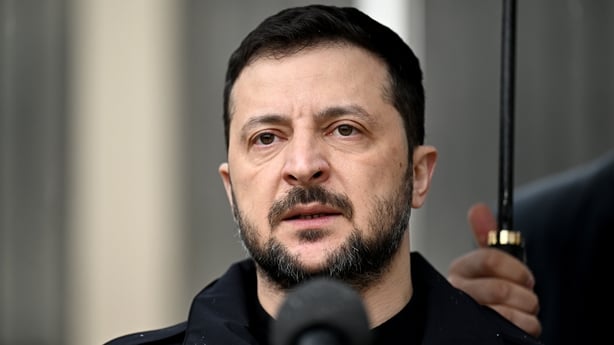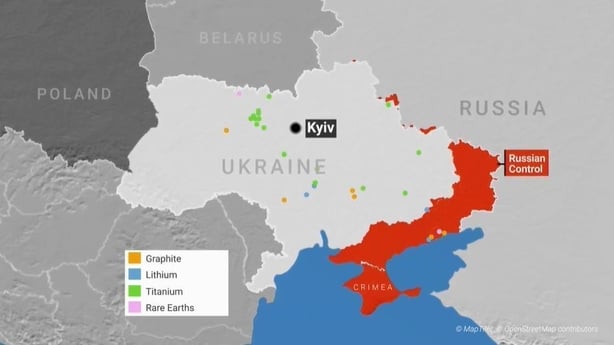Ukraine's vast undersoil mineral wealth is at the heart of an economic deal which the country is currently in the final stages of negotiations for with the US.
Confirmation of the agreement is considered key to US support for ending Russia's three-year war in Ukraine.
However, the terms of the complex pact have been a source of friction between the US and Ukraine in recent weeks.
Background to deal
Ukraine's President Volodymyr Zelensky initially floated the idea of opening its critical minerals to investment by allies last autumn, as it presented a "victory plan" that aimed to put it in the strongest position for talks and force Russia to the table.

After taking office, US President Donald Trump then took up the offer. But his proposal for the US to take control of $500 billion (€477 billion) in mineral wealth from Ukraine to repay the US for wartime aid was rejected by the Ukrainian president.
Mr Zelensky said the terms did not contain the security guarantees he wanted, and were not in Ukraine’s interests.
"I won't sign a document that ten generations of Ukrainians will pay for, " Mr Zelensky stated.
He also disputed a claim made by Mr Trump that the US had spent $350 billion on Ukraine’s war efforts.
Research from the Kiel Institute for the World Economy suggests that figure is actually closer to $120bn.
In recent days, talks have been continuing towards a more palatable version of the deal, with Ukrainian Deputy Prime Minister Olga Stefanishyna confirming yesterday that the two sides were "close".
In a post on X, she said signing it would "showcase our commitment for decades to come."
Later that day, the US President signalled plans to meet his Ukrainian counterpart at the White House this week or next to finalise the deal.
Ukraine's mineral reserves

Most importantly, Ukraine is sitting on one of Europe's largest deposits of critical minerals, which are used across a range of industries including technology, aerospace, defence and energy.
For the US, having access to these resources would reduce its dependency on China, by far the world's leading exporter of critical minerals.
According to analysis from The Kyiv School of Economics (KSE), Ukraine has 116 valuable types of minerals, in around 20,000 locations.
Most of these mineral fields are unexplored, with only 15% active prior to the Russian invasion.
The list of Ukraine’s valuable minerals includes graphite, which is used to operate nuclear power stations and batteries; titanium used in aerospace, defence and industry; lithium, a key component in electric car batteries; and rare earth minerals, which are found in a range of electronic devices.
According to the KSE, Ukraine holds the largest titanium reserves in Europe and a third of the continent’s lithium reserves.
However, up to 20% of the country's resources - including around half its rare earth deposits - are currently under Russian occupation in eastern Ukraine, as stated by President Zelensky in an interview with Reuters on 7 February.
How the deal would work
The details of the deal in its current form have not been published yet.
However, Axios is reporting that the draft agreement includes the establishment of a "Reconstruction Investment Fund" that will be co-managed by the US and Ukraine.
It says the fund will be designed "so as to invest in projects in Ukraine and attract investments to increase development," including in areas like mining and ports.
The draft seen by Axios expresses a desire that Ukraine remain free, but does not specify any US military commitment.
Challenges for potential investors
Questions have been raised about the investment and skills required to explore and mine Ukraine’s vast mineral fields.
Dr Jakob Kullik, a Political Scientist specialising in the geopolitics of critical minerals, said the deal may look attractive on a political level, but on a practical level its benefits for the United States are less clear.
"A huge problem for the US is that there are not many American companies who are able to mine and to process these rare earth elements, because Chinese companies have dominated this sector for two decades," he said.
Furthermore, the threat of further conflict and land expropriation in Ukraine may put off would-be investors.
According to the Centre for Strategic and International Studies, it takes an average of 18 years to develop a mine - and costs between $500 million (€477m) and $1 billion (€954m) to build.
Analysts have said confidence in the political and economic stability of Ukraine would be critical, given the size and longevity of the investment.







